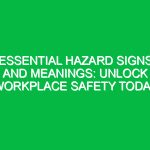Introduction
In an ever-evolving world where health, safety, and environmental (HSE) concerns are increasingly paramount, understanding hazard sign meanings is crucial for ensuring safety in various settings. Hazard signs are visual indicators designed to communicate specific dangers associated with particular actions, environments, or materials. Their clear and standardized meanings play a vital role in preventing accidents, injuries, and environmental damage. As such, mastering the meanings behind these signs is not just beneficial; it is essential for anyone involved in workplaces, public spaces, or activities that could pose risks to health and safety.
The significance of hazard signs extends beyond mere compliance with regulations; they serve as immediate visual cues that can save lives. From construction sites to chemical plants, understanding these signs can empower individuals to act swiftly and appropriately in the face of danger. This article explores the intricate meanings of various hazard signs, their implications in the HSE context, and the best practices for interpreting and responding to them.
Understanding Hazard Sign Meanings
Hazard signs are typically categorized into several groups, each with its distinct purpose and design. Familiarizing oneself with these categories is the first step in enhancing HSE awareness.
Types of Hazard Signs
- Warning Signs: These signs alert individuals to potential hazards that may not be immediately apparent. They often feature a yellow background with a black symbol. For instance, a sign depicting a falling object warns of overhead dangers.
- Prohibition Signs: Indicating actions that are not permitted, prohibition signs usually have a red circle with a diagonal line through it. An example is a sign stating “No Smoking,” which is critical in flammable areas.
- Mandatory Signs: These signs specify actions that must be taken to ensure safety. They are typically blue and white, such as a “Hard Hat Required” sign.
- Emergency Information Signs: Providing crucial information in emergencies, these signs often feature green backgrounds. For instance, a sign directing individuals to the nearest exit can be life-saving in an evacuation scenario.
Understanding these categories allows individuals to quickly assess the nature of the hazard and respond accordingly.
Common Hazard Sign Meanings
To further illustrate the importance of hazard sign meanings, let’s delve into some commonly encountered signs and their implications in the HSE context.
- Chemical Hazard Signs: Signs indicating the presence of hazardous chemicals are crucial in environments like laboratories and industrial settings. For example, a sign with a skull and crossbones signifies poison, alerting personnel to the dangers of toxic substances.
- Electrical Hazard Signs: A sign depicting a lightning bolt warns of high-voltage areas. This is vital for both workers and visitors to prevent accidental contact with electrical sources.
- Biohazard Signs: Represented by a distinctive symbol, biohazard signs indicate areas where biological agents are present. These signs are critical in healthcare settings, laboratories, and waste disposal areas.
- Forklift Signs: In warehouses or distribution centers, signs indicating “Forklift Traffic” warn pedestrians to be cautious of moving vehicles, reducing the risk of accidents.
Each of these signs conveys vital information that can significantly impact safety and well-being.
Real-Life Scenarios: The Impact of Hazard Sign Awareness
Understanding hazard signs can have real-world implications. Consider a scenario in a manufacturing plant where workers frequently encounter chemical substances. A lack of awareness regarding the meanings of hazard signs can lead to mishaps. For instance, if a worker ignores a sign indicating “Corrosive Material” and fails to don appropriate personal protective equipment (PPE), the consequences could be severe, including chemical burns or respiratory issues.
Alternatively, in a construction site, a clear understanding of a warning sign about falling objects can prompt workers to wear hard hats and remain vigilant. This proactive approach significantly reduces the risk of injury, showcasing how hazard sign meanings translate into practical safety measures.
Best Practices for Hazard Sign Interpretation
To promote effective communication of hazards, organizations should implement best practices for the interpretation of hazard signs.
Training and Education
Regular training sessions should be conducted to educate employees about the various types of hazard signs and their meanings. Incorporating real-life examples and case studies in training can enhance understanding and retention. For instance, discussing a recent incident involving a misinterpreted hazard sign can drive home the importance of awareness.
Signage Maintenance
Regular inspections of hazard signs are vital to ensure they remain visible and legible. Faded or damaged signs can lead to miscommunication and potentially dangerous situations. Organizations should establish a maintenance schedule to address any signage issues promptly.
Clear Communication
In addition to traditional hazard signs, organizations should consider supplementing them with clear verbal communication. This could involve safety briefings or issuing alerts regarding specific hazards present in the work environment.
Regulations and Standards Governing Hazard Signs
The significance of hazard sign meanings is reinforced by various regulations and standards that govern workplace safety. In the United States, the Occupational Safety and Health Administration (OSHA) has established guidelines regarding hazard communication, including the proper use of signs. These regulations are designed to ensure that workers are informed about potential hazards and can take appropriate precautions.
Globally, the Globally Harmonized System of Classification and Labelling of Chemicals (GHS) provides a framework for hazard communication, emphasizing the need for standardized symbols and signs. Understanding these regulations enhances HSE awareness and facilitates compliance, ultimately leading to safer environments.
Conclusion
In summary, hazard sign meanings play a critical role in ensuring health, safety, and environmental protection. By understanding these signs and their implications, individuals can take proactive measures to safeguard themselves and those around them. The significance of effective hazard communication cannot be overstated; it is a fundamental component of any robust safety program.
As workplaces continue to evolve, fostering a culture of awareness around hazard signs is essential. Organizations must prioritize training, maintenance, and clear communication to reinforce the importance of hazard sign meanings. By doing so, we can contribute to a safer future, where the risks associated with various environments are effectively managed.
In closing, take a moment to reflect on your surroundings. The next time you encounter a hazard sign, remember that it could be the key to preventing an accident and promoting safety. Awareness is the first step toward a safer environment for everyone.


